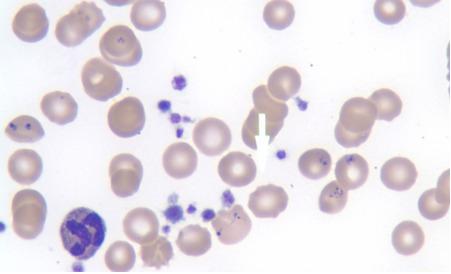As much as 70% of patients who receive radioactive iodine therapy go on to develop hypothyroidism within 10 years of treatment. Complications like cholestasis and granulocytopenia are linked to anti-thyroid therapeutic alternatives like prophylthiouracil. Surgery for the thyroid, such as a sub-total thyroidectomy, increases the danger of harming the recurrent laryngeal nerve. Hemorrhage, hypoparathyroidism, and hypothyroidism are further problems. No proof exists that radioactive iodine therapy can raise the risk of developing cancer.

Doxycycline, Quinine, and Clindamycin. Babesia parasites are visible in a blood smear. The most typical form observed under a microscope is a ring-shaped structure with pale blue cytoplasm and one to two red chromatic spots. These ring forms can be mistaken for Plasmodium falciparum trophozoites due to their resemblance in appearance. Babesiosis is transmitted by ticks and can be fatal, especially in those who have had their spleen removed. Babesiosis, Lyme disease, and Human Granulocytic Anaplasmosis can all be seen together since all three diseases are spread by the deer tick (Ixodes scapularis). In patients with healthy immune systems, sickness may be asymptomatic or mild. Atovaquone and azithromycin are the recommended treatments for babesiosis, while Clindamycin and Quinine are preferable when a patient is very unwell. As indicated above, co-infection is common, thus doxycycline should be added while awaiting results from other laboratories. This patient has tachycardia, hypotension, a fever of 103, and is severely dehydrated. Additionally, due to his splenectomy, he is at a significant risk for decompensation.
Bone tumors known as giant cell tumors (GCT) are often benign yet complicated. Years after the original diagnosis, they frequently spread to the lymph nodes or lungs and are known to be locally harmful. In about 10% of instances, local recurrence following therapy is a problem. Despite making up less than 10% of all primary tumors, GCTs tend to affect younger persons (ages 25 to 40) and women more frequently than other populations. One of the common complaints is a pain that slowly becomes worse near the tumor's site. A pathological fracture triggers a diagnosis in 15% of circumstances. Upon inspection, there can be a palpable enlargement that is warm, sensitive, or has a restricted range of motion. A well-defined, lucent "soap bubble" look is a distinctive feature of radiographs. Surgery, specifically intralesional excision by "extended" curettage, is the basis of treatment. Recurrence locally is frequent.
Please select 2 correct answers
The number of cancer survivors has increased as a result of advancements in cancer therapy. Many of these survivors deal with a variety of lifelong issues like melancholy, worry about recurrence or relapse, infertility, toxic side effects from treatment such neuropathy, and secondary cancers. An anthracycline was used to treat the patient in this case, which is known to increase the risk of myelodysplastic syndrome and acute leukemia. According to one series (Campone et al. Annals of Oncology 2005), the risk applied to only 1% of all treated individuals. Chemotherapy is frequently ineffective for those who acquire therapy-related MDS or AML, and their survival is usually only moderately long. Secondary leukemias and cardiomyopathy are linked to anthracyclines.
It would be best to supplement the effects of bronchodilators by lowering inflammation around the airways using an intravenous steroidal drug, such as hydrocortisone.
Sepsis is an infection-related Systemic Inflammatory Response System (SIRS). Based on her history of alcohol use and a chest x-ray finding, this patient has sepsis that is most likely caused by aspiration pneumonia. According to recommendations for sepsis patients, the following procedures should be carried out within three hours of triage: lactate levels should be monitored, blood cultures should be taken, broad-spectrum antibiotics should be given, and aggressive IV fluids should be given if hypotension is present. Within six hours of triage, vasopressors should be provided if hypotension is still present. If arterial hypotension persists despite fluids, central venous pressure and oxygen saturation should be evaluated.
The other symptoms described can all be seen with an exacerbation of his COPD and do not necessarily imply any factors that would result in an incurable lung lesion. In a patient with chronic obstructive pulmonary disease (COPD), recent changes in the change of voice suggest lung carcinoma (the hoarseness is due to metastatic disease involving recurrent laryngeal nerve, which indicates extra pulmonic spread and incurability by surgical means. Patients who have malignant pleural effusions, evidence of contralateral lymphadenopathy or lung involvement, or any extra pulmonic spread are not considered surgically curable (although chemotherapy and radiation therapy in patients with oat cell carcinoma of the lung can cause remission, these therapies are not curative).